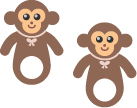A method for teaching math:
The Flash Method


Doman’s Philosophy
The method of teaching babies with flash cards was pioneered by Glenn Doman, founder of the Institutes for the Achievement of Human Potential (IAHP), a nonprofit organization that teaches parents how to maximize the potential of their brain-injured or normal child. Doman published his seminal book How To Teach Your Baby Math in 1979.
Doman stresses that the younger a child is, the easier she is to teach. In his book he states that children under the age of two and a half (and some slightly older children) have the ability to perceive quantity. Another way to explain this is to say that very young children can “subitize” large quantities – that is, they can instantly perceive how many items are in a relatively large set, without counting or guessing. For more on this, go to Perceiving Quantity (Subitizing).
As a parent, you can make use of this natural ability to teach your child about the true nature of quantity. The first step of the math program, therefore, consists of teaching numbers as quantities, rather than the symbols (numerals) used to represent them.
Understanding numbers in this way enables children to instantly “see” the solutions to equations involving addition, subtraction, multiplication and division. And while the ability to subitize large quantities fades as children grow older, the ability to do instant math need not – so long as lessons with quantity were started at a young enough age.
The Doman method is relatively flexible – parents can, and should, put their own stamp on their child’s program of learning. Doman often writes “after a few weeks” when describing when to move on to a subsequent stage of teaching. Some parents would prefer to be told exactly what to do when, but this approach reflects the importance Doman places in moving at a pace that suits the individual child. In any case, his instructions are for the most part clear and detailed.
There is no definite end to the program – rather, teaching and learning are seen as ongoing, lifelong processes. The ultimate aim of the Doman program is to make the child fluent in the “language” of math. As Doman points out, math “literacy” and a love for math are qualities unfortunately lacking in many of us.
For more on the importance of mathematics, and a discussion of why you might consider giving your child a head start in the subject, go to Why Teach Math Early?
Shichida’s philosophy…